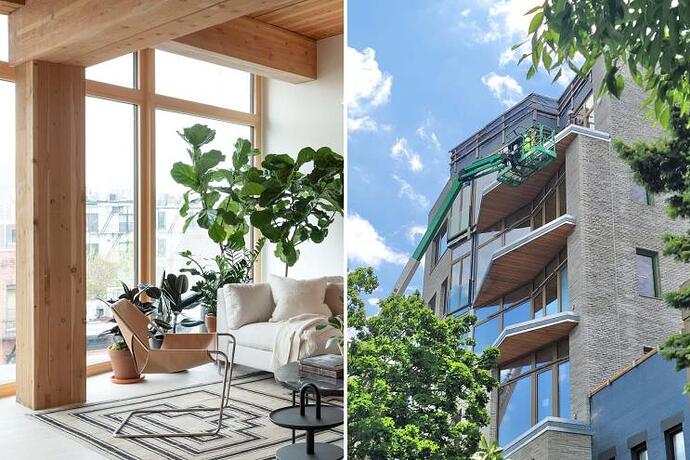By Lois Weiss
October 27, 2022
Architects and developers across the globe are racing to build a new breed of structures created not from the cast iron, masonry or steel of yesteryear, but from one of the planet’s most abundant renewable resources: trees.
Known in the biz as “mass timber,” buildings made from good old-fashioned wood are lighter, structurally stable and better still, dramatically reduce carbon footprints. Timber can also significantly reduce construction time.
“Mass timber is really a strong example of how to apply natural principals to buildings,” said David Briefel, design resilience leader and sustainability director at Gensler architects’ NYC office.
“You use small [compressed] pieces as it allows the quicker growing trees to be harvested so you don’t need old-growth trees,” added Brent Buck of his eponymous architecture firm.Although New York City developers and architects have been exploring the construction of 12- to 20-story mass-timber projects for several years, city code — which requires a special permit for wooden structures — is just not that limber regarding timber. Yet.
A new building code that allows for as-of-right shorter structures and new wood products known as “cross laminated timber” (CLT) arrives Nov. 7.
CLT is composed of at least three layers of either wood or structural composite lumber glued together perpendicularly. The layers are very thick — think 2-by-4s glued together. The resulting hunk can be flat or curved and can be prefabricated to as much as 60 feet long and 10 feet wide.
“This allows you to span in two different directions,” Briefel said.However, the new code will require these timber buildings to top out at just 65 feet or six stories unless an automatic sprinkler is included, which provides a 20-foot bump to 85 feet or seven stories.
Buildings of this size require an elevator, concrete-enclosed fire stairs and hallways — making them larger and more expensive to build, explained Vishaan Chakrabarti, founder of PAU, Practice for Architecture and Urban Planning.
The new timber code also requires sprinklers for residential buildings over three stories.
While it’s not as liberal as the International Building Code, which allows timber to rise to 270 feet or 18 stories, it’s a start.
In fact, a handful of short-scale timber projects in NYC already serve as proof of concept. The city already allows “glulam,” aka glue laminated timber (GLT), in certain instances, but architects say CLT provides more flexibility for designs.
Nearly a decade ago, architect Hugh Hardy designed the New York Botanical Gardens Leon Levy Visitor Center in The Bronx using mass timber for its stunning covered pavilions.
More recently, during the pandemic, Flank Architects opened 320 and 360 Wythe Ave. in Brooklyn as a timber post and beam warehouse-like office project with street retail. The three-story buildings each have ground-floor retail and two stories of offices. Retail rents range from $140 to $175 per foot with office asking rents at $65 per foot.
Meanwhile, the Brooklyn Home Company along with Mesh Architects are now wrapping up construction on “Timber House,” a new six-story, 14-unit luxury condominium building with a shared roof deck at 670 Union St. in Park Slope.
The units were designed with a “modern tree house” aesthetic while incorporating solar photovoltaic panels and other green elements. Already 13 of the 14 units — including some with private terraces and views of Manhattan — are in contract for just over $1,580 per foot, as are most of the 11 parking spots. The remaining unit has three-bedrooms and 3½ baths in its 2,041 square feet and a tab of $3.2 million.
“All of the major rooms have exposed timber ceilings and you see the columns and beams,” said Eric Liftin, of Mesh Architects, a partner in the project. “You don’t have to clad the structure in other materials.”Constructed using GLT under the prior building code, it also has a concrete foundation, stairs, elevator cores and lot line walls.
“I am very eager to do more buildings like this,” said Liftin, who is on the lookout for sites and hopeful the city will allow taller towers.
Brent Buck Architecture is currently designing a 15-unit residential project at 122 Waverly Place in Clinton Hill.
While at least 40 wooden structures are in the design phase across in New York State, the rest of the world, and even the rest of the country, is far ahead of NYC in terms of timber construction.
There are currently eight taller projects in the works and roughly 180 commercial wooden structures in development in the US, said Bill Parsons, COO of the Woodworks Innovation Network, a non-profit that provides technical support and catalogs the timber projects.
Since 2019, Norway had boasted the world’s tallest timber project, Mjøstårnet, with 18 stories and 280 feet that used concrete in its seven upper floors to stop the sway. But New Land Enterprises now has the record with its 25-story, 284-foot-high Ascent — a 493,000-square-foot apartment building in Milwaukee, Wis. It has seven parking levels with 18 stories of apartments now filling up at rents starting at just over $1,700 for a one-bedroom.
Not to be outdone, Danish architects Schmidt Hammer Lassen have designed Rocket&Tigerli, a terracotta-clad residential and mixed-use project with a tower hitting 328 feet to be built in Winterthur, Switzerland, near Zurich.Jamestown, the Atlanta-based developer which operates Chelsea Market and owns 1 Times Square, is designing a prototype for a mid-rise mass-timber residential building that could end up in any one of a number of cities where they own land.
Why design a building without a home? That’s because mass timber enthusiasts are still waiting for state, city and local codes to catch up with the new building products.
“Finding the right spot,” Jamestown’s President, Michael Phillips, lamented, “is the challenge.”
